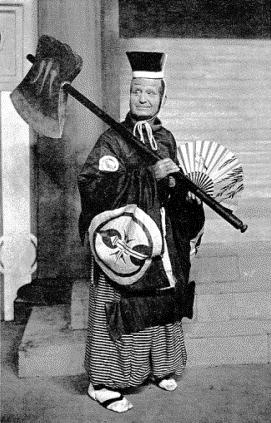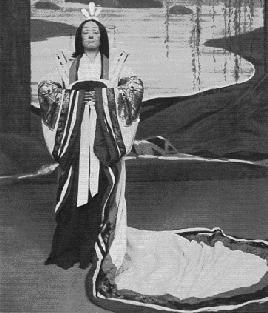The 1926 BBC Mikado Broadcast
Reported by Robert Morrison
| The Mikado | Darrell Fancourt |
| Nanki-Poo | Charles Goulding |
| Ko-Ko | Henry A. Lytton |
| Pooh-Bah | Leo Sheffield |
| Pish-Tush | John Huntington |
| Yum-Yum | Elsie Griffin |
| Pitti-Sing | Aileen Davies |
| Peep-Bo | Beatrice Elburn |
| Katisha | Bertha Lewis |
The D'Oyly Carte Opera Company
Conductor: Dr. Malcolm Sargent
[Editor's Note: On Monday, September 20, 1926, the BBC broadcast live excerpts from The Mikado, from the stage of the Princes Theatre. The occasion was the new production designed by Charles Ricketts. What parts of the opera the radio listeners heard is not recorded here, but accounts of the groundbreaking production make fascinating reading in their own right. The new production was truly a major event in D'Oyly Carte history. Besides the radio broadcast, there was a new recording for HMV and an experimental color film made.]
The D'Oyly Carte's 1926 London season was significant for a number of reasons as related in the following extract from Clemence Bettany's comprehensive history of the company included in the souvenir booklet D'Oyly Carte Centenary 1875-1975: 100 years of D'Oyly Carte and Gilbert and Sullivan, (published by the D'Oyly Carte Opera Trust in 1975):
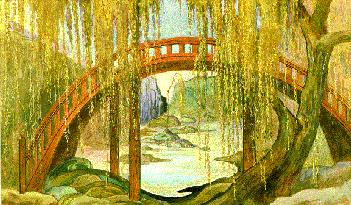 Charles Ricketts's design for Ko-Ko's Garden, Act II |
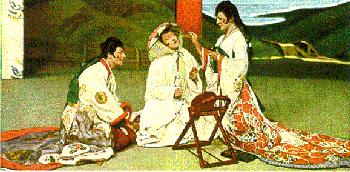 Pitti-Sing (Aileen Davies) and Peep-Bo (Beatrice Elburn) attend Yum-Yum (Elsie Griffin) |
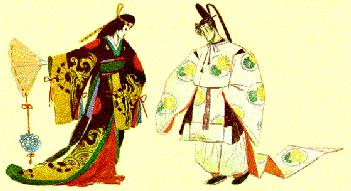 Ricketts's costume sketches, including that for The Mikado |
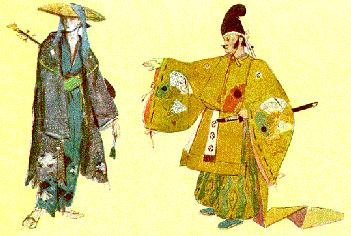 Designs for Nanki-Poo and Pooh-Bah |
The 1926 season in London brought a new conductor to the rostrum at the Princes, Dr. Malcolm Sargent. Unhappily for the fans, Utopia was not among the operas. Instead there was a new Mikado, entirely redressed with sets by one of the most talented scene designers of the day, Charles Ricketts. It was the first time since the original production that there had been fresh designs for the opera. Ricketts was well known for his attempts to dispel what he called the visual literalness of the English stage. For the costumes he went back to 17th century Japan but the designs were not copies. They were derivative not imitative. In an interview Ricketts explained, "I have followed the Japanese custom in that there is a different design for the dress of each separate member of the chorus. At that time the ladies of the Court wore their hair long and plaited like a horse's tail. They had a fringe on the forehead and sidewhiskers.[!] The common people wore kimonos, but not men of breeding. They wore quite distinct Court dress with trains, and long sleeves on which their coats of arms were embroidered. I have purposely refrained from copying any particular heraldic devices, because I do not wish to give offence to any Japanese family".
On opening night (20 September), the B.B.C. relayed two excerpts live from the stage of the Princes. It was the first time they had been allowed to do so. Among the audience inveterate G & S first nighters greeted each other and publicly acknowledged old favourites with cries and cheers. [The Prime Minister, Stanley] Baldwin was also there, his presence indicated by Lytton in "Never would be missed" by the lighting of an imaginary pipe. Instead of the "lady novelist"; there was now the "scorching motorist".
By definition, traditionalists hate change and the new costumes and sets were disliked on principle. In addition, complaints were made of Sargent's reading of the music. He was accused of putting in orchestral "gags". As the original orchestral scores had never been published there were very few individuals who knew what was in them. One who did was Malcolm Sargent. He had been entrusted by Rupert D'Oyly Carte with the original score of The Mikado to study. As Carte pointed out in a letter to the press, Sullivan's score had been followed down to the very last semi-quaver. The argument provoked an old member of the orchestra to recall Sullivan himself at a band call in 1895 for a revival of The Mikado when he interpolated some notes in the bassoon part and remarked to the rest of the orchestra that he had been waiting for ten years for the opportunity to add that particular 'gag'.
The London Times noted the following programme highlights and details in the edition published on Monday, September 20th, 1926; page 9:
From London and the country stations of the British Broadcasting Company tonight there will be broacast two extracts from The Mikado, with which the Gilbert and Sullivan season will be opened at the Princes Theatre. Among those in the cast will be Mr. Darrell Fancourt, Mr. Charles Goulding, Mr. Henry A. Lytton, Mr. Leo Sheffield, Mr. John Huntington, Miss Elsie Griffin, Miss Aileen Davies, Miss Beatrice Elburn, and Miss Bertha Lewis. The transmissions will be at 8-15 and 10-30, and will both last half an hour.
Under 'PROGRAMMES' The Times listed that the excerpts would be broadcasted on LONDON - Call 2LO (365 metres) and DAVENTRY - Call 5XX (1,600 metres), between 8-15 p.m. to 8-45 p.m. and 10-30 p.m. to 11 p.m.
The following day an anonymous critic in The Times [21 Sep 1926, p. 12 reviewed the stage performance itself as follows:
The Mikado, refurbished in some of its details, made a brilliant opening to the eagerly awaited season of Gilbert and Sullivan operas begun at the Princes Theatre last night.
Henry Lytton as Ko-KoRefurbishing of any sort is regarded with some slight suspicion by the faithful, and we are all for the purity of the text of both words and music. Mr. Henry Lytton, however, has so long been allowed to put "the scorching motorist" into the catalogue of people who "never would be missed" that probably most of his admirers have forgotten who the "singular anomaly" of the 'eighties really was, and he now by implication, though not by name, makes the "apologetic statesmen of a compromising kind" refer to gentlemen who were not on the political stage of the 'eighties. Mr. Lytton, however, is a law to himself. He at any rate shows more respect for Gilbert's words than for Sullivan's notes, though he still manages to give the gist even of the latter.
A refurbishing noticeable for the first time in this performance is a little more shocking to the faithful, and that is certain orchestral "gags" for which we must assume Dr. Malcolm Sargent, who now for the first time has charge of the musical direction, to be responsible. It seems a little dangerous to deck "Three Little Maids from School," "Tit Willow," and other numbers with these things, however pretty or amusing they may be, the more so since the full scores of the operas have never been published. Is Sullivan to be gradually buried beneath additional accompaniments, like Handel? Let us hope not.
These glosses, however, were not very obtrusive, and the outstanding pleasure of this performance was its musicalness. Dr. Sargent was thoroughly successful in getting that crisp finish to the ensemble and the right relation between singers and band on which these inimitable operas depend for their full effect. If once or twice the tempi were so quick as to make the singers gabble, that seemed to be partly because the singers were determined to show that they could do it. It was certainly Miss Bertha Lewis who forced the pace of "There is beauty in the bellow of the blast."
The admitted refurbishing consisted of new scenery, new dresses, and new properties designed by Mr. Charles Ricketts, which in the mass made a highly effective scheme of colour. The Mikado dressed like that may or may not be more Japanese than the old setting; it is certainly less English. Again, the faithful may complain that it is less "Gilbertian," that Yum-Yum and her companions should remain pretty girls according to thoroughly Western notions, whatever their dresses may be, and that the Japaneseness should not be allowed to go further than the bric-à-brac of the mid-Victorian drawing-room.
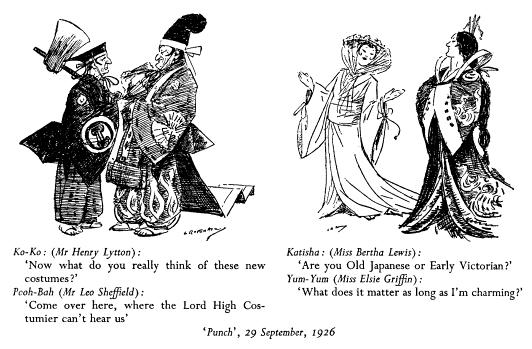 Punch's Comment on the New Costume Designs |
In the company itself, at any rate, there was not much refurbishing. Miss Elsie Griffin might not look quite the Yum-Yum we have known, but with Miss Aileen Davies and Miss Beatrice Elburn as her efficient supporters she gave the same charm to the entrance of the three little maids, and sang "The Sun and I" with the same freshness as formerly. Mr. Charles Goulding's voice was a little apt to be hard in forte passages, and it stood out too much in the famous "Madrigal," which was not very well balanced in tone, but he is on the whole a pleasant and personable heir to the throne disguised as a second trombone.
Bertha Lewis as KatishaMiss Bertha Lewis, in a truly wonderful Queen of Spades costume, was majestic as Katisha. She excelled in the finale to the first act by getting a serious dramatic significance into her part and illustrating the fact that the humour of Gilbert and Sullivan comes out best by serious treatment. One gets a little tired of the underlined fun of the ostensibly comic characters. Still we must not underrate the value to the company of such well-tried friends as Mr. Lytton and Mr. Sheffield, the latter as "tremendous" a swell as ever and more gorgeously attired. Mr. Darrell Fancourt undoubtedly loses a good deal of the Mikado's humour by underlining it to the extent that he does, and his "humane Mikado" scene is the one which seems to have travelled farthest from the "Savoy tradition." If there are some points in which we should like to see a return to that tradition there was last night one point which was an undoubted improvement on it. The overture was listened to in complete silence, and well repaid the listening. It is evidently becoming recognized that, after all, Sullivan is the dominant partner, and that it is the music which revives again the wit of Gilbert."
[With regard to the reviewer's comment that the overture was listened to in complete silence, perhaps the audience was on its 'best behaviour' knowing that it was being broadcast on radio!]
The next day The Times published the following letter [Wed. 22 Sept. 1926, p. 8]:
To the Editor of the Times.
Sir, — Your critic writes of orchestral gags and additional accompaniments in last night's performance of The Mikado. Dr. Malcolm Sargent has most carefully studied the original full score of this opera and, in addition to piano rehearsals with principals and chorus, has had six hours of orchestral rehearsals with the full score before him. His main object this season is to bring out the full beauty and humour of Sullivan's orchestral colouring. It would seem that he was so successful in this respect last night, and that the details of the orchestration sounded so fresh, that some of the critics thought them actually new. That is not the case, however. Not one note has been added to Sullivan's score or any alteration made, with one unimportant exception, that being the illustration of "He whistled an air," the tune of "The girl I left behind me" being given; this has been done for many years in place of the original and now unknown popular air Sullivan first used. With this exception the opera was played last night exactly as written by Sullivan.
R. D'Oyly Carte
Savoy Hotel, W.C.2, Sept. 21
On the following Monday The Times published the following letter [Mon. 27 Sept. 1926, p. 8]:
The introduction of orchestral "gags" into the rendering of The Mikado is not altogether a novelty. I remember years ago being told by one of the members of the orchestra that the players themselves used to invent these "gags," and that one day when Sullivan turned up to conduct the opera he expressed his approval of them.
— Rev. Geoffrey C. E. Ryley
The day before The Mikado opened at the Princes, George Baker and the D'Oyly Carte's male Chorus entered H.M.V.'s London studios and recorded "Our great Mikado," thus inaugurating the first of H.M.V.'s Electrical G&S sets. Just over a week later on the 29th September the recording schedule continued with the Overture, Opening Chorus and "A Wandering Minstrel I." Further sessions followed over the ensuing months until the opera's recording was finally completed in early December. With the exception of Derek Olham singing the role of Nanki-Poo and George Baker singing that of Pish-Tush, the personnel that featured in the recordings was largely the same as the stage cast noted above. The conductor of the recording was Harry Norris, D'Oyly Carte's resident musical director, who, although familiar with the recording studio, was conducting his first (of three) Electrical G&S recordings.
Given that The Times reviewer noted that Lytton regularly substituted "the scorching motorist" in Ko-Ko's little list for the "singular anomaly" on stage, Lytton's subsequent substitution of "the prohibitionist" in his 1926 recording of the song was evidently regarded as a less-jarring anachronism. (And one that Americans of the time could easily relate to, since they could not legally obtain intoxicating beverages in their country again until 1933!)
In Martyn Green's Treasury of Gilbert & Sullivan, [Simon and Schuster, New York; 1960], in addition to the above Green lists several alternative "singular anomalies" used over the years including "the jazz-time pianist" and "the girl who's not been kissed!"
